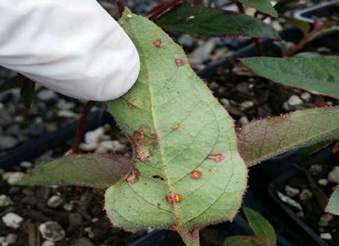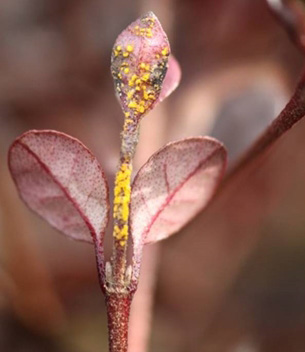PESTS AND DISEASES OF FORESTRY IN NEW ZEALAND
A Myrtle Rust Overview
Scion is the leading provider of forest-related knowledge in New Zealand
Formerly known as the Forest Research Institute, Scion has been a leader in research relating to forest health for over 50 years. The Rotorua-based Crown Research Institute continues to provide science that will protect all forests from damage caused by insect pests, pathogens and weeds. The information presented below arises from these research activities.
From Forest Health News 275, September 2017.
A Myrtle Rust Symposium was held at Auckland University in August to provide an up-to-date snapshot of the myrtle rust (Austropuccinia psidii), situation in New Zealand and overseas. Over 100 people attended, including invited overseas scientists, researchers at CRIs and universities, government agencies, councils, and arborists.
A high level overview of the situation in New Zealand was given by Dr Ian Ferguson (MPI) from the Myrtle Rust Strategic Science Advisory Group. He discussed development and governance of the national biosecurity risk posed by myrtle rust and the on-going necessity to ensure that New Zealand has the capability and systems in place to cope with the incursion.

MPI’s level of response for an invasive organism and the difficulties in eradicating myrtle rust were presented by Dr George Gill on behalf of Dr Rebecca Martin (MPI), providing information on many factors including the impact on human health, environmental, economic and sociocultural values. It is estimated that, if myrtle rust establishes in New Zealand, there would be a 0.1% drop in gross domestic profit and a decrease of 0.5% in activity relating to the Myrtaceae species affected.
Myrtle rust is expected to have a strong impact on New Zealand native Myrtaceae species as it has not coevolved with our native plants. In Australia, field observations and tests have shown that 350 species are susceptible.
Dr Beccy Ganley (Scion) gave the audience a glimpse of what was involved when surveying for myrtle rust, including the level of decontamination required by surveillance crews to prevent spread of the rust fungus. Based on overseas experience, the spring foliage flush is expected to be very susceptible and therefore a critical time in the incursion response.

Dr Phil Cannon (USDA Forest Service) talked about the different strains/biotypes of myrtle rust worldwide and the variation in host susceptibility and environmental tolerance. He emphasised that the spores of all strains/ biotypes are tough and spikey, which enables them to be easily spread. Dr Ned Klopfenstein (USDA Forest Service) followed with a more detailed investigation
into the genetic structure of A. psidii strains/biotypes and the climatic suitability for establishment worldwide. The biotype present in New Zealand is the known as the ‘pandemic biotype’ and is the same as that present in Hawaii, Australia and other countries. Assoc. Prof. Janice Uchida (University of Hawaii) gave us a glimpse into the myrtle rust situation in Hawaii. Since the arrival of myrtle rust in 2004, it has severely impacted Syzygium jambos (rose apple). Rust spores in Hawaii are produced in such large quantities on infected plants growing on stream margins that they can be found floating in the streams. The need for control to commence before rust symptoms appear was highlighted.
Closer to home, Dr Angus Carnegie (NSW Department of Primary Industries) and Dr Geoff Pegg (Queensland Department of Agriculture and Fisheries) gave overviews of the situation in Australia. Two native species have recently been put on the ‘critically endangered’ list as their populations have been severely affected by myrtle rust. With this in mind, Australia is using a ‘conservation model’ to assist with making decisions on native plants.
Worryingly, the Australians are seeing a change in species composition in natural forests as the new regeneration or coppices generated by forest fires are highly susceptibility to myrtle rust and the rust has also had an effect on flowering of many plant species impacting natural succession.

Dr Wellcome Ho (MPI), discussed the consequences of sexual reproduction by A. psidii resulting in the recombination of genes that could result in the appearance of new strains at a greater rate. He also presented work by Stuart Fraser (Scion) and South African colleagues showing evidence of sexual recombination in the South African strain of A. psidii.
In addition, two presentations of overseas disease threats currently not present in New Zealand were given. Dr Lisa Keith (USDA/ARS) talked about two species of Ceratocystis (rapid 'Ohi'a death) causing widespread mortality of Hawaii’s native ohi'a lehua (Metrosideros polymorpha). Dr Andrew Pitman (Plant and Food) discussed the bacterium Xylella fastidiosa, transmitted by insects. This bacterium has a broad host range infecting over 300 plant species, including grapes and olive trees, and is considered one of the most harmful plant pathogenic bacteria.
The day was hosted by Better Border Biosecurity (B3), Centre for Biodiversity and Biosecurity, Plant and Food Research, United States Department of Agriculture, Ministry for Primary Industries (MPI) and Scion.
A selection of the presentations can be found online here: http://scienceevents.co.nz/myrtlerustsymposium/ programme/presentations
Judy Gardner & Beccy Ganley
This information is intended for general interest only. It is not intended to be a substitute for specific specialist advice on any matter and should not be relied on for that purpose. Scion will not be liable for any direct, indirect, incidental, special, consequential or exemplary damages, loss of profits, or any other intangible losses that result from using the information provided on this site.
(Scion is the trading name of the New Zealand Forest Research Institute Limited.)

 Farm Forestry New Zealand
Farm Forestry New Zealand

